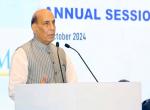One of the most keenly watched part of the Union budget is the allocations of funds for defence expenditure. Given the prevailing security environment, modernization of the armed forces and keeping them militarily prepared is a major challenge faced by both the political and military establishments. Particularly so given the fact that our relations with two important neighbours; Pakistan and China can at best be said to be in cold storage, with little sign of early thaw.
Adding to above challenge is the two front threat that Army believes it faces requiring a much higher degree of defence preparedness and above all military readiness. The latter is more relevant, whose components are not mere force structures and modernisation but includes preparedness and sustainability as well. This was alluded to by the Prime Minister in his address to Combined Commanders Conference in 2009, when he said that the armed forces have to be ready to fight anywhere, anytime and under any conditions.
Above basically implies that defence policy, doctrines and strategy, funding and structures, together with capabilities and capacities, and logistical sustainability must be of the order that allows India to use its military power to support its national interests in concert with the vision set forth by the Prime Minister.
The Union Budget 2011 - 12 bears analysis from the above perspective of defence preparedness and readiness. This year the Finance Minister has allocated Rs 164,415 crores for defence. Above allocation signifies an 11.6% increase from Rs 1, 47,344 crores allocated last year. This increase was backed by the usual announcement that 'funds will never be a constraint for meeting the genuine needs of the armed forces'. However, such a caveat is of no practical significance; what it hides is the absence of long term commitment of funds by the Finance Ministry to Five Year Defence Plans. Apart from some exceptions made in the wake of events like Kargil war or Mumbai terror attacks the increase in defence expenditure has generally followed the trend line of 10 percent increase every year. Thus, for financial babudom the defence budget is merely an
exercise in accountancy. It can not be said that there is some long term vision attached to this annual exercise in defence budgeting.
While the Ministry of Defence and HQ Integrated Defence Staff have been involved in making Five Year Defence Plans (FYDP) and Long Term Integrated Perspective Plans (LTIPP) it is very rare that they are approved in time by the government. For instance, the FYDP 2007-12 which should have been approved before 2007 has not been approved so far. In fact, it is in the danger of not being approved in the plan period despite many remonstrations by Parliament's Standing Committee on Defence (SCD).
Further, the MOD had promised to the SCD of the 14th Lok Sabha that LTIPP consisting of three plan periods would be based on articulation of National Military Strategy (NMS) which in turn will be based on formulation of National Security Strategy (NSS). This was to be done by 2009; however, the new SCD of 15th Lok Sabha composed of new members seems to have forgotten about the same. In all their reports since 2009 the SCD has not raised any observations on the non-articulation of NSS and NMS. While the defence forces are talking about transformation and revolution in military affairs there is a considerable degree of skepticism on the conceptual philosophy about modernisation of the armed forces. Some analysts have rightly worded such an approach to military modernisation as 'arming without aiming'.
Reverting back to the current year's budget the sub allocation of above budget - Rs 99387.85 crores is planned to be expended towards revenue expenditure and balance 69,199 crores is earmarked for capital expenditure. In terms of percentage it is mere 1.83 percent of GDP and nowhere near the often sighted figure of 3 percent sought by the services for filling the essential strategic voids. Addressing the Combined Commanders Conference in 2005 Prime Minister Manmohan Singh had indicated the possibility of earmarking 3 percent of the GDP if the economy continues to grow at 8 percent of the GDP. Looking at the worsening asymmetries against our likely adversaries, time has come to
convert that possibility into reality. Evidently, rise in defence expenditure would have to be spread at least over one plan period.
A close look at the Capital Expenditure which is essentially meant for meeting our modernisation needs would reveal that complete Capital allocation is not for new acquisitions. It is important to note that as a rough yardstick, only three-fourths of the capital expenditure budget goes towards capital acquisition, balance being allocated for creation of capital assets etc. Out of that balance acquisition budget, approximately 60% is already earmarked for payment toward committed liabilities i.e purchases already made with deliveries in the pipeline. That leaves around 30% of the capital budget available for new defence purchases. As a rough estimate about Rs 20,000 crores are available for new acquisitions but in real terms close to 60,crores, given the long gestation period for defence contracts to be executed. The SCD , in end 2009, while reviewing the projections for the remaining two years of the Eleventh Plan had observed that capital budget requires growth of 35.96 per cent and 17.13 per cent respectively for the years 2010-11 and 2011-12 over the Budget Estimates of 2009-10. Thus, the growth of capital segment of the budget is inadequate.
As per estimates based on the current (2007 - 12) and next (2012 -17) Five Year Defence Plans, armed forces are slated to spend nearly $100 and 120 billion on military hardware in these two plan periods respectively. In addition the LTIPP (2012 - 2027) envisages substantial procurement of land, air and naval systems with a view to field lethal, mobile and networked defence forces in the future. Thus huge sums are being spent upon procurement and capability building but the question is do we get the desired payoffs?
Basic issue that needs to be addressed is that is above allocation together with the committed liabilities enough to meet the modernisation requirements of the services to meet security challenges faced by the country? Two issues are important in answer to above question; one what are we modernizing for? Does our military modernization in optimum terms help in threat mitigation? Which underlines an even more fundamental question what is the nature of conflict envisaged and likely conflict scenarios that the country must prepare for and invest?
Scenario in terms of current threat perspective is that Pakistan has been raging a proxy war against India with near impunity for which we have at best a defensive answer in terms of effective Low Intensity Conflict Operations (LICO) strategy. On the other hand our conventional edge is
getting slowly eroded owing to delay in Services modernization plans and infusion of modern military hardware into Pakistani armed forces from both China and elsewhere. Above has substantially neutralised India's capacity at conventional deterrence in the backdrop of nuclear overhang where too Pakistan according to published reports has forged ahead both in terms of fissile materials and vectors. Above means that our ability to execute any punitive pro active strategy and manage escalation is incrementally getting restrained, if anything our response to 26/11 is an example.
In so far China is concerned it is marching ahead in its military modernization with focus on modernization of its armed forces primarily through indigenous defence industrial base and developing new capabilities in terms of cyber, information, missile and space warfare. China has been increasing its defence budget in double digit percentages since 1989. This year's increase has been to the tune of 12.7 percent; it is also well known that there is a great degree of opacity about China's defence spending- the actual figure could be twice of the claimed figure. However what is to be noted is that China is creating a potential to project power anywhere around its near abroad. In short, asymmetry between India and China in military terms is on the rise. What is important is that China intends to employ these standoff capabilities to execute what it calls 'No Contact War' aimed at strategic dislocation.
In the face of above challenges our focus remains on attritional force on force kind of warfare mindset, underlined by our desire for platform centric procurement- in effect justifying the observation of arming without any strategy. As a result not enough attention is being paid toward developing adequate offensive defence capabilities based on developing operational systems within the overall 'system of systems' approach or creating truly synergised force capabilities. This demands among others capacities of fielding an integrated C4ISR system that integrates sensors, decision makers and platforms. Here sensors are as or more important than platforms; thus we need to enhance ELINT and Space capabilities, develop capacities for a constant ISR cover over areas of interest and those we would like to influence. Similarly more attention needs to be given to not only defensive but offensive information and cyber war capabilities and developing Anti Ship Ballistic Missile and Anti Satellite Capabilities.
True defence capability must ensure dissuasive deterrence and maximisation of India's strategic space to ward of future challengers and create an environment for India's peaceful economic growth. Using national resources to raise formations, or mere platforms would not suffice. India needs a system centric approach to its defence capability development. Till then we would be using buzz words like defence transformation, net centric warfare or RMA while merely attempting to address the obsolesce factor with no real capability enhancement.
---------------------------------------
Published Date : March 8, 2011









Post new comment